One worrying thing I've noticed from compiling this list is that only one companion actor from the 60s, Michael Craze, who played Ben Jackson, has died while four companions from the 70s--Caroline John, Ian Marter, Elizabeth Sladen, and Mary Tamm--have died. Did people eat and exercise better in the 60s?
Okay, from worst to best:

40. Adric
No surprise here, we all hate Adric, don't we? Sometimes I think that, in much the way Star Trek: The Next Generation seems to have based the Borg on the Cybermen, maybe Gene Roddenberry said, "Hmm, looks like Doctor Who has a really annoying, whiny, genius kid," and Wesley Crusher was born. Is there Adric/Wesley slash fiction out there? I imagine them getting excited bragging to each other about their grades in school and compliments they've received from Picard or the Doctor.

39. Mel Bush
For gods' sakes, someone save her from that blouse. Easily the worst dressed companion, aiming for something like fast food chic, her wardrobe was matched by a helium voice delivering a sitcom performance.
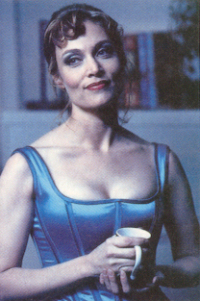
38. Grace Holloway
Sure, the bad dialogue wasn't her fault and she didn't have long to establish herself but at the end of the day she was dull as dirt when she wasn't delivering tone deaf lines.

37. Ian Chesterton
The Man for Manliness sake at the beginning, there to be smug and reassuring and hit things in 1963. Someone, it seems, had to fill that role in the early 60s and maybe we should thank Ian for doing it so it wasn't the Doctor instead.
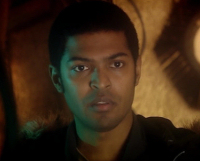
36. Mickey Smith
One of the many pointless, fifth wheel companions of the new series there's consequently not much to say about Mickey. Sometimes his whining was annoying but mostly he was barely noticeable.

35. Ben Jackson
An indistinct character who basically filled space.

34. Polly
The other half of Ben, the two were basically one character but I'm giving her a higher spot for being better looking.

33. Dodo Chaplet
A bit shrill and unexciting but she had a funny name.

32. Rory Pond
Another of the fifth wheels but probably the one with the most personality. Still, it's frustrating to think how much better Amy Pond's story could have been without him around.
31. Erimem
I've only listened to one story so far about this ancient Egyptian princess but, hey, she's an ancient Egyptian princess. Why aren't there more companions like that on the TV show?

30. Kamelion
Only appearing in two episodes (and a deleted scene from one episode), this fellow sadly proved to be too complicated to implement on a long term basis but I found some charm in the weird, clunky puppet.
29. Frobisher
I've only heard one audio play with this character though I understand he has quite a history in prose and comics. I can see how the shapeshifter who's usually a penguin and talks like a stevedore could be annoying but I actually found him slightly refreshing for his roughness around the edges.

28. Susan Foreman
Her habit of pleading in all situations could be annoying but sometimes she was an effective point of view character to communicate the threat of a monster.

27. Harry Sullivan
Assigned, like Ian, to be the Man he was unexpectedly hedged out by the more than adequate in all ways Fourth Doctor. But I kind of liked his self-consciously old fashioned quality and it would have been nice to hear Sarah Jane shoot down more of his casual sexism even as I enjoyed his use of dated terminology.

26. Peri Brown
What can I say about an actress hired for her breasts? She had great breasts. Can't act, though, and her fights with the Sixth Doctor were tedious.

25. Victoria Waterfield
There mainly to scream and be protected, it was still nice having a Victorian character along to be really weirded out by the future.

24. Barbara Wright
There to be dependent on Ian's Manliness, Barbara nevertheless came across a bit steely.
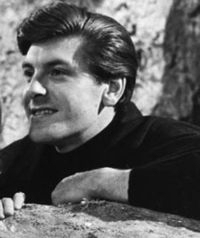
23. Steven Taylor
Another resident Man, Steven managed to come off as not half so smug as Ian, managed to look like he respected the at this point constantly fumbling William Hartnell, and had a good rapport with Vicki.
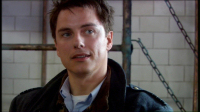
22. Jack Harkness
Smugness we're meant to like yet with a respectfulness, there was a hint of exciting adventure about Jack that might pay off if I ever get around to watching Torchwood.
21. Evelyn Smythe
It's always tricky giving a well educated companion to the Doctor when the function of the companion has classically been to give the Doctor someone to explain things to. So Evelyn's intelligence has been dumbed down in a couple audio plays but I still like her concept and she may be the best thing about the Sixth Doctor, not counting Peri's breasts.
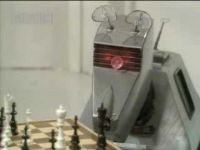
20. K-9
It's easy to see how a robot dog would just be annoying but it's mainly the Fourth Doctor's easy going bemusement around his dog that makes K-9 work. Oddly, the concept is sort of part of the character as Baker's affection seems to be as much for the very idea of a robot dog as for the robot dog itself, as though he's just tickled that someone really, truly thought this was a good idea, an attitude that David Tennant adopted well in his encounter with K-9.

19.Tegan Jovanka
She seems a bit too worried most of the time but there was a kind of laser focus about Tegan I liked.
18. Charley Pollard
A companion from the 1930s, Charley is easily head and shoulders above her predecessor, Grace. She keeps her head, too, even when she's terrified and provides interesting insight.

17. Jo Grant
Injecting a hint of 70s glam rock with her style, she was a bit of an airhead but pretty and exhibited an attractive enthusiasm.

16. Vislor Turlough
I found Turlough's treacherous streak really interesting and the actor's performance made his cowardice an interesting layer of personality.

15. Martha Jones
A somewhat bland performance and most of the best episodes of her season had little to do with her. But she didn't really do anything wrong and she had great rapport with Tennant in her introductory episode.

14. Rose Tyler
I have to admit I don't quite understand Rose's popularity but her early episodes with the Ninth Doctor were a wonderfully effective gateway into the kinds of stories Russell T. Davies wanted to tell.
13. Bernice Summerfield
This is a character with a long history in prose and audio I've only just scratched the surface of but I was immediately impressed by her laid back, confident, and intelligent humour, the sort of things the show usually reserves for male characters.
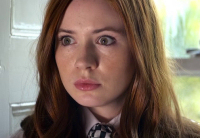
12. Amy Pond
Sadly hampered by a pointless spouse, Amy's adventures where she has the Doctor to herself are nonetheless memorable. And she even had a few bright moments later, like "The Girl Who Waited".
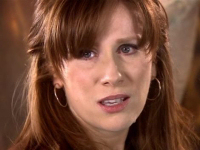
11. Donna Noble
By far my favourite Russell T. Davies era companion, "The Runaway Bride" is one of my favourite Christmas specials, second only to "The Snowmen". Of course, she suffered from the uniformly downwards in quality trajectory of all Davies' seasons but she injected a great sensibility, a very human counterpoint for the Doctor, into episodes like "The Fires of Pompeii" and "Silence In the Library".

10. Vicki
Intended as essentially a replacement granddaughter, Vicki's cool mischievousness couldn't be suppressed under a role written as a dependant ward and her and the Doctor have a sparkling chemistry in "The Romans."

9. Zoe Heriot
Another kid genius but thankfully much sassier and not quite as full of herself. She's adorable but she doesn't let herself be defined by it like Adric seems to--his task being especially misguided for the fact that he's not adorable.

8. Ace
I'm ignoring the fact that she said in an audio play that she doesn't like Radiohead, Ace was a welcome respite after two dimensional and screechy companions. Who else would beat a Dalek with a baseball bat? It's always a joy to see her have an idea about how rigging explosives might be helpful.

7. Sarah Jane Smith
Kind of the prototypical companion, she could be effectively terrified but, by her second season with Tom Baker, she was able to stand toe to toe with the Doctor, too. She had two different kinds of chemistry over the course of her original run with the Doctor--the Lois Lane-ish intrepid reporter who gets into trouble for the Third Doctor and then a delightful partner in crime for the Fourth Doctor in his second season.
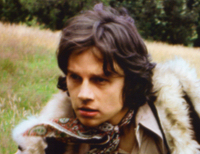
6. Jamie McCrimmon
The best of all the companions from Earth's past, Jamie strides into the future with an air of mildly exasperated disapproval, his shaking his head at the nonsense in Tomb of the Cybermen or The Dominators never gets old and he's solid in a fight, too. His chemistry with the Second Doctor, who always seems to be flustered by Jamie's arguments regardless of being invariably right, is endlessly charming.
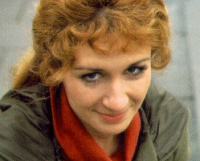
5. Liz Shaw
Possible inspiration for the main character of Ridley Scott's Prometheus, Liz Shaw's tenure was much too short. A scientist who seemed downright sexually attracted to the Doctor's acumen, she was nonetheless written under her intelligence in some cases, hamstrung by the need for the Doctor to have someone to explain things to. But there was something unmistakable in Caroline John's and Jon Pertwee's eyes when they looked at each other.

4. Nyssa
Here's a character who's really blossomed in the audio plays. On the show, she was fine but always felt a little superfluous, probably because she wasn't originally intended as a companion, becoming one only after popular demand following what was intended to be a one-off appearance in Keeper of Traken. So began the era of the Fifth Doctor's ever overcrowded TARDIS. The fact that the Master was wandering around inhabiting the corpse of Nyssa's father was criminally unexploited. But in the audio plays, where Nyssa and the Fifth Doctor have a lot more one on one time, she takes on the role of a sensible minder for the Doctor's sometimes carelessness as his thoughts get ahead of him and her conflicts with the spirituality of her homeworld's philosophy are interestingly played out.

3. Clara Oswald
By far the best modern companion, Clara's generally unhampered by an extraneous boyfriend character allowing the strange facets of the Doctor/companion relationship to be explored in ways they hadn't been before. There's the usual hint of romance but also the wonderfully troubled adjustment to regeneration. And when it looked like Clara was getting a boyfriend, instead of being a tedious tangent, it was used to further explore her relationship with the Doctor which became an intriguingly confusing mix of lover and parent and finally just alien.

2. Leela
She starts well as a scantily clad savage with a knife who thrills in the kill but she quickly adjusts to futuristic settings and environments without losing her identity. She doesn't really sacrifice her more cut-throat principles to the Doctor's pacifism and yet both characters respect the other's philosophy.

1. Romana
Many would argue I should divide Romana into two characters for the Time Lady's two incarnations but . . . I'm not going to for some reason, even though I do prefer Lalla Ward's incarnation. Mary Tamm as the first incarnation is still wonderful and she establishes the absolutely unique rapport she has with the Doctor of mutual respect. But the Doctor still has someone to explain things to as Romana hasn't been around the universe as much as he. When Lalla Ward took over there was something of the "partners in crime" chemistry he had with Sarah Jane Smith but much more natural and the two had a very clear, very beautiful mutual admiration, sadly lost in the audio plays after Romana becomes president. Which seems like a decision made by writers who fundamentally didn't understand that what made the Doctor and Romana so charming was the impression of two interlopers showing up everyone by just being there. Which is traditionally the fun of the Doctor by himself but with Romana, there were two, and it was really sexy.
















